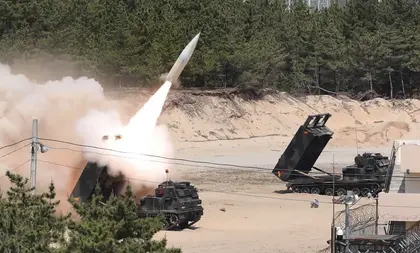The White House’s recent 180-degree reversal of a longstanding ban on Ukrainian strikes deep into Russia using American ATACMS missiles is unlikely to affect the course of the war, but it probably will degrade the Russian air force’s ability to bomb Ukrainian civilian and military targets somewhat, a Monday Kyiv Post review of Kyiv’s past use of the weapon found.
Based on the track record of the Armed Forces of Ukraine (AFU) use of the weapon so far, the AFU is most likely to use new deliveries of ATACMS missiles – always provided the US actually delivers them – to strike at Russian military aircraft, air bases, and air defense systems, Kyiv Post researchers found.
JOIN US ON TELEGRAM
Follow our coverage of the war on the @Kyivpost_official.
The ATACMS is a ballistic missile that flies in a high, parabolic trajectory at hypersonic speeds, can carry close to a half-ton warhead payload, and is accurate down to a few meters. Russia claims its air defense systems are proof against it, but combat has shown ATACMS can and have destroyed those top-end Russian systems, even if their radars see the ATACMS coming.
Ukraine, in September 2023, reportedly received its first batch of 10-15 ATACMS M39 ATACMS missiles, a weapon with a 150-kilometer (93-mile) range. A US condition of arms transfer was a ban against using the weapon against targets inside Russia because the White House judged that Ukrainian strikes into Russia with a made-in-USA-weapon might make Russia retaliate.

Azerbaijan Opens War Crimes Trial of Armenian Separatists
Fully sixteen months after Russia invaded Ukraine and Kyiv filed its first requests to Washington for long-range weapons to defend itself, on Oct. 17, 2023, ATACMS missiles struck a pair of Russian military airfields. It was Ukraine’s first-ever confirmed battlefield use of the weapon.
One salvo hit a Russian military air base in occupied Ukraine near the Azov Sea port city of Beryansk, and another, a Russian military airfield in the occupied Luhansk region. Eyewitnesses told of between two and four missiles used in the strike, some with cluster munition warheads.
By all accounts, including Russian, the M39 missiles, a 1990s-vintage weapon with a maximum range of 165 kilometers (103 miles), were wildly successful. Satellite imagery later showed close to twenty attack and general-purpose helicopters destroyed or seriously damaged. Air defense batteries, headquarters buildings, pilot and ground crew barracks, fuel storage sites and ammunition bunkers also were hit in the raids, called “Operation Dragonfly” by Ukraine’s military special operations branch the SSO.
On Oct. 25, according to Russian sources, Ukrainian strike planners expended a pair of ATACMS missiles against an advanced Russian S-400 air defense system deployed in the occupied Luhansk region. Russian official sources said all the ATACMS were shot down. Ukrainian military spokesman said the S-400 was demolished but declined to identify the weapon used. Local social media and later satellite imagery told of explosions and a big fire and ATACMS debris found where the S-400 used to be.
On Oct. 31, Ukrainian missiles hit a Russian S-300 air defense system deployed near the occupied Crimean city of Yevpatoriya. A few Russian milbloggers claimed it was ATACMS, but Russian official statements said it was British or French cruise missiles.
In total, following the White House’s September decision to arm the AFU with old-model M39 ATACMS missiles, the AFU appears to have received about ten weapons and shot them all off in a few weeks, always targeting either airfields or anti-aircraft systems, Kyiv Post researchers found.
According to Ukrainian media reports, the AFU immediately asked the White House for more ATACMS, as many as America could send, but the Biden administration demurred, citing concerns about escalation with Russia, along with Pentagon worries about depleting stocks.
After a nearly six-month hiatus, on April 17, 2024, twelve Ukrainian missiles pounded a Russian military airfield near the occupied Crimean town of Dzhankoi. Reportedly, up to 50 combat aircraft were on the tarmac at the time of the 3 a.m. attack. The base was at the outside edge of the 150-kilometer (93-miles) M39 ATACMS range envelope.
Russian media widely reported that US-made MGM-140 ATACMS ballistic missiles, the longer-ranged version of the M39 missile, had carried out the strikes. Eyewitnesses said the missiles came in two waves, the first armed with cluster munitions targeting parked aircraft, and the second with high explosives warheads to hit fuel and ammunition storage.
Likely follow-up ATACMS strikes hit the Dzhankoi air base again on Apr. 30. The same day, Russian military airfields near the cities of Simferopol and Sevastopol, and the towns of Gvardeyska and Evpatoria also were hit by a total of 10-12 missiles. As in the April raids, based on satellite images and eyewitness reports, the AFU targeted Russian aircraft, air defense systems and air base infrastructure.
On May 10, one or two reportedly ballistic-type missiles struck and set afire a Russia-operated oil depot in the Luhansk region town of Rovenky. Social media imagery of missile debris seemed to show the weapon used as an M39, however, that claim was never confirmed.
On May 15, an unreported number of ATACMS missiles again hit the Crimean airfield of Belbek, near the city of Sevastopol. As in past strikes, the missiles come at night in two waves, the first targeting aircraft and the second aiming for base infrastructure. Drone video and later satellite images showed between two and eight Russian Su-27-series fighter jets were destroyed or badly damaged. Local reports and Russian official statements said between three and six ATACMS missiles made the attack.
On June 23, a reported four or five long-range missiles, possibly ATACMS, again struck Crimea, near the town of Evpatoriya. One probably intercepted weapon struck a beach crowded with civilians, killing three people and injuring 124, Russian news reports said. Later reports confirmed the Ukrainians probably had targeted air defense installations across the peninsula and possibly destroyed an S-500 battery, a system billed by the Kremlin as the world’s most advanced and designed to shoot down ballistic ATACMS missiles.
On July 17, the Ukrainian army announced and published drone images confirming it had used four, shorter-range M39 ATACMS missiles to destroy a Russian anti-aircraft position near the occupied Donetsk region city of Mariupol. A little more than a week later, on July 26, the Novofederivka airfield near the Crimean town of Saki was hit, likely by two ATACMS.
In total, the AFU, from April to May 2024, had available to it and launched 30-35 longer-ranged (300-kilometer / 186-mile) MGM-140 ATACMS missiles, and four to five shorter-ranged (150-kilometer / 93-mile) M39 ATACMS missiles.
Since then Kyiv Post researchers found no instances of even a probable ATACMS strike, on any of the Russo-Ukrainian War’s fighting fronts. Reports of more Ukrainian pressure for more missiles, and the American release to use them in Russia, gained pace, and by the end of August, the Zelensky administration had sent the White House a draft target list of sites inside Russia that might be hit.
In the throes of what proved to be an eventually unsuccessful election battle to keep the US Presidency and Senate controlled by the Democratic Party, the Biden administration did little. White House officials repeatedly argued that ATACMS missile strikes in Russia would escalate the war and not substantially aid Ukraine’s cause. In October US Defense Secretary Lloyd Austin told reporters more ATACMS in Ukrainian hands would have little effect “because all the Russian planes have left.”
Based on past strikes, the preferred Ukrainian tactic for ATACMS has been to wait until Russian air operations planners concentrate aircraft at airfields known to be in potential ATACMS range but for operational reasons seen worth taking the risk of using.
Transient aircraft that can be caught on the ground, as well as ammunition bunkers and fuel depots that cannot fly away, have always been the top AFU targets for the about four dozen ATACMS missiles Ukraine has actually received, Kyiv Post research found.
You can also highlight the text and press Ctrl + Enter










